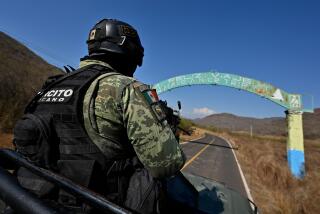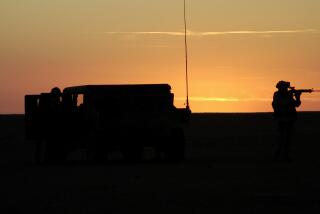Some troops have sixth sense for bombs
- Share via
TWENTYNINE PALMS MARINE BASE, CALIF. — As Marines train to deploy to war zones, there is daily discussion about how to detect and disarm the buried roadside bombs that are the No. 1 killer of Marines in Iraq and Afghanistan.
Military researchers have found that two groups of personnel are particularly good at spotting anomalies: those with hunting backgrounds, who traipsed through the woods as youths looking to bag a deer or turkey; and those who grew up in tough urban neighborhoods, where it is often important to know what gang controls which block.
Personnel who fit neither category, often young men who grew up in the suburbs and developed a liking for video games, do not seem to have the depth perception and peripheral vision of the others, even if their eyesight is 20/20.
The findings do not surprise Army Sgt. Maj. Todd Burnett, the top enlisted man with the Pentagon-based Joint Improvised Explosive Device Defeat Organization, or JIEDDO, which conducted the study. He’s made multiple deployments to Iraq and Afghanistan and ridden in more than 1,000 convoys and, on 19 occasions, been in a vehicle hit by a roadside bomb.
The best troops he’s ever seen when it comes to spotting bombs were soldiers from the South Carolina National Guard, nearly all with rural backgrounds that included hunting.
“They just seemed to pick up things much better,” Burnett said. “They know how to look at the entire environment.”
Troops from urban backgrounds also seemed to have developed an innate “threat-assessment” ability. Both groups, said Army research psychologist Steve Burnett, “seem very adaptable to the kinds of environments” seen in Iraq and Afghanistan.
Video game enthusiasts are narrower in their focus, as if the windshield of their Humvee is a computer screen. “The gamers are very focused on the screen rather than the whole surrounding,” said Sgt. Maj. Burnett (no relation to the research psychologist).
About 800 military personnel at Twentynine Palms and several other bases took part in a complex set of vision and perception tests, follow-up interviews and personality tests. Test subjects were asked to find hidden bombs in pictures, videos, virtual reality exercises and open-air obstacle courses, including on pitch-dark nights.
Although many of the findings remain classified -- lest the enemy discover what the U.S. has learned about its methods of burying and detonating the devices -- military officials agreed to discuss the eyesight portion of the study.
The study was completed in June, and its results are being circulated for peer review to researchers with security clearances. It took 18 months to carry out and cost $5.4 million.
After eight years of war and billions of dollars spent on electronic detection, the best technology for spotting improvised explosive devices, or IEDs, remains the sharp-eyed Marine, soldier or sailor.
Of the bombs spotted before they could kill or maim, an estimated 90% were detected by someone, for instance, sensing something amiss along a dusty roadside in the southern Afghan province of Helmand or a crowded street in the western Iraqi city of Fallouja.
The insurgents’ use of roadside bombs has become a kind of war-within-a-war. Insurgents have improved their tactics for placing, hiding and exploding their bombs; the U.S. has become better at spotting and defusing them.
In Afghanistan, there have been fewer roadside bombs than in Iraq but they are more powerful.
“When they come after you, they come with their ‘A’ game,” said Marine Corps Staff Sgt. Stephen Gouak, who has deployed as a demolition expert to Iraq and Afghanistan. “They don’t seem to have the resources to waste like the Iraqis.”
Marines preparing for deployment are put through realistic scenarios to sharpen their skills at finding bombs buried in a roadside or spotting bomb ingredients inside a messy home. To add to the realism, furniture and rugs and household goods seized in Iraq have been brought here to create a mock village. Marines are taught how to use robots to defuse bombs.
Battalions that go to the mountain warfare training center at Bridgeport, Calif., in the eastern Sierra are sent on a 68-mile overland convoy route to the Hawthorne Army Depot in Nevada. Along the route are simulated bombs and Marines playing the part of insurgents, attacking from ambush and firing AK-47s.
At Twentynine Palms, a program is being developed to tutor troops in the characteristics of the many varieties of improvised explosive devices used in Afghanistan. In a country with few paved roads, U.S. vehicles are forced to drive over dirt and sandy paths where bombs are easily buried.
Gouak and other instructors at the explosive ordnance disposal school here were not involved in the JIEDDO study. But they are not surprised to learn that rural and urban backgrounds are common characteristics of good bomb-hunters.
“Let’s be honest: That’s a big percentage of the Marine Corps. You don’t get Harvard graduates becoming Marine privates,” said Chief Warrant Officer Seth Leonard, who hunted squirrels as a youth in Tuscaloosa, Ala., and is now operations officer for the school.
To the two desirable background categories found by the research, Gouak, who grew up in rural Pennsylvania, thinks one more group should be added as particularly dedicated to spotting bombs.
“Anybody who has lost a buddy to an IED,” he said. “They never stop watching.”
--
More to Read
Sign up for Essential California
The most important California stories and recommendations in your inbox every morning.
You may occasionally receive promotional content from the Los Angeles Times.










